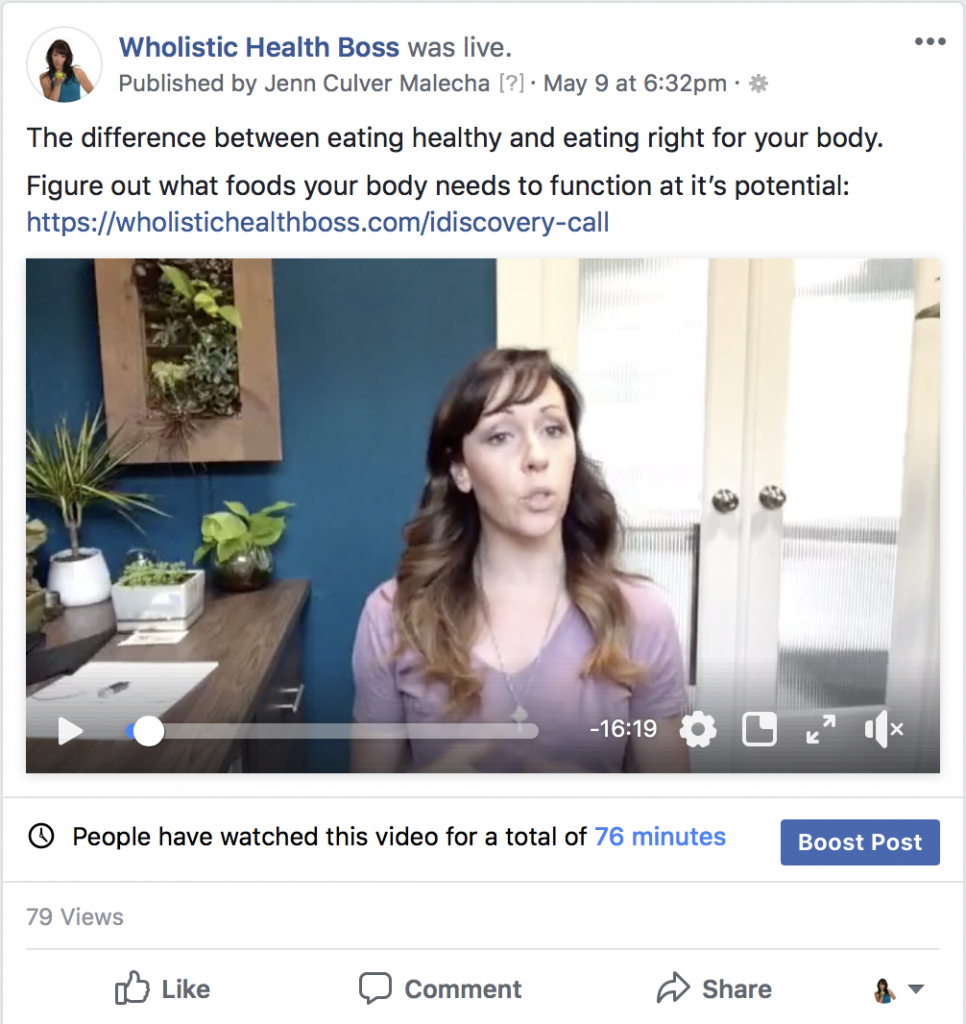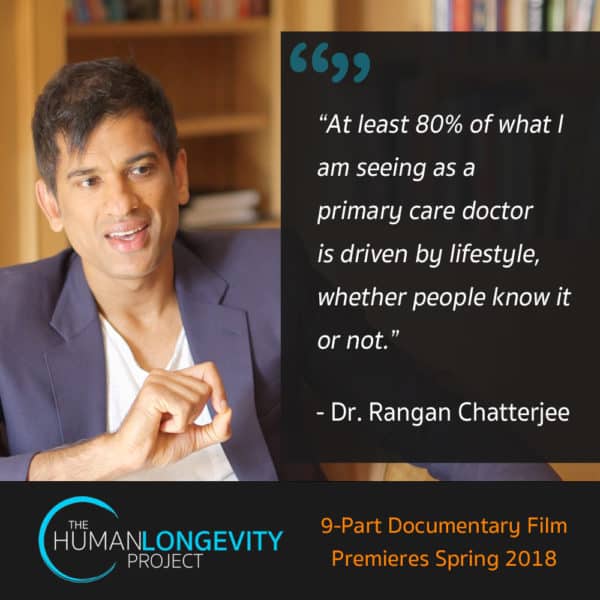#TBT – Full Moon’s Effects On Your Health

Does tonight’s full moon have you feeling kind of funny?
Do you feel more bloated, lethargic, constipated, an increase in anxiety or digestive upset?
It’s time for another #throwbackthursday blog to explain why!
P.S. I’m going straight old school here, this blog was before I re-branded as (W)holistic Health Boss, so don’t get confused when I say TravelFit, LOL. The info is still completely relevant and this has been one of my most popular and commented on blogs ever over the years!
***
You might think this is a little superstitious, but there is something real about how the full moon impacts people, animals and the things around us.
You can call me crazy, but just hang in here with me for a minute…
Have you ever noticed with yourself or others that there seems to be something cyclical when it comes to being moody and irritable (and I’m not talking about PMS)? A fluctuation in mood that only lasts for a few days for some reason and is unexplainable?
Or what about sleep disturbances- going through periods of time when you have trouble falling asleep or tossing and turning that only last for a few days or a week at a time?
How about your digestion? Do you experience phases of really great bowel movements and then all of a sudden they seem to go on the fritz?
And then there’s stuff such as skin rashes or breakouts, teeth grinding, and joint aches and pains. Do those come and go every few weeks, too?
Looking back now, were any of these things, or other ailments that you might suffer from worse this past week or so leading up to the recent full moon?
It’s not a coincidence, it’s science.
In this week’s video and blog I talk more about the scientific connection with the full moon cycles, your gut and what to be on the lookout for.
During a full moon, ocean tides are higher than usual from an increase in the gravitational pull from the moon and sun. Considering that the body is 80% water, scientist and astrologers have often thought that similar effects happen in the body creating almost a “human tidal pull” that can affect brain function.
But PARASITES are likely the real thing driving you crazy or causing suffering during a full moon.
The gravitational pull on water balance in the kidneys causes a shift of movement or an “awakening”, making these little buggers more active during the full moon cycle, wreaking havoc on your gut, digestion and hormone balance. Overgrowth of gut bacteria and/or yeast can also have similar effects during a full moon.
Textbook symptoms of parasites can include:
- Bloating, gas, fatigue or flu-like symptoms
- Low immune function (get sick or allergies often)
- Excessive hunger, constipation or diarrhea
- Teeth grinding, especially at night, and other sleep disturbances
- Hives, irritability, rashes or headaches
- Changes in weight and increases in joint pain
The most common parasites in my health coaching practice is Blastocystis Hominis.
Blasto can be persistent and it likes to hang out with another gut offender, H. Pylori bacteria. H. Pylori’s classic symptoms include: heartburn/acid reflux, ulcers, migraines and mid-back pain.
But there are a bunch of different gut bug species that could be disrupting you. We come across them all the time, and if the gut is already compromised they can move in quick and take over.
So here’s what I want you to do.
Now that the full moon has officially risen and we’re moving into a new moon cycle, I want you to jot down any symptoms, aches, pains, ailments or health complaints that you’ve been experiencing this past week.
Then you’ll start tracking the progress of those things. You’re looking to see if they improve and/or go away in the coming weeks, especially leading up to the next new moon in a few weeks when these gut infestations are mostly dormant.
If you suspect you have a gut bug now or after tracking, then feel free to schedule a FREE Ideal Health & Weight Discovery Session with me to chat about the right plan of attack for you.
***
P.S. If you want to learn more about gut bugs and all things gut related then check out my Leaky Gut: The Missing Link to Better Health, Hormones & Happiness webinar replay here.
My top 10 fave pantry foods…

Do you ever wonder if what you’re eating is actually healthy for you?
Or are you curious to know what other healthy people are eating?
Sometimes you can put yourself in a box when it comes to food choices because you just don’t know what else to eat, maybe you don’t feel creative in the kitchen or simply because you’ve become accustomed to your routine.
This can leave you feeling deprived and down right unsatisfied.
Many of my clients feel this way about food when we start working together, but over time as they learn what foods are right for their body and they start thinking outside of the box, trying new foods, they ultimately find their food freedom for life!
The truth is, there are hundreds and thousands of different healthy foods out there for you to try.
As my health journey started to evolve years ago, one of my favorite hobbies was going to Whole Foods at night so that I could leisurely walk through the aisles and find new healthy food goodies after the crowds had left and without any pressure.
I tried a lot of good tasting stuff, some not so good tasting stuff, and I learned more about what to look for.
Now with the rising popularity of online shopping with companies such as Thrive Market, it has become even easier to access healthy AND good tasting foods right at your doorstep.
But that doesn’t mean you know what to buy.
In this week’s video and blog I share with you what I look for in a “healthy” food and my top 10 favorite foods in my pantry.
When I first switched to eating an anti-inflammatory, more organic and whole foods based diet I remember feeling lost about what to eat and what to look for.
Food labeling and marketing isn’t exactly the easiest thing you’ll ever read.
When I look at food labels for any boxed, bag or canned food items, I’m primarily looking for 5 things in this priority of importance as it relates to my health…
- Gluten free
- Organic and NON-GMO
- Dairy free
- No added or artificial sugar
- Soy free
The tricky part is that these ingredients aren’t always listed in plain english. They can show up as whey (dairy), barley or rye (gluten), soy lecithin (soy) or as something such as sucralose (Splenda).
So I simply default to the list of allergens on the food label, where by law a food manufacturer at least has to list in plain english if a food contains any of the 8 major allergens.
If the allergens section of the food label says “contains” wheat, dairy or soy, I avoid it. If there sugar is listed in the nutrition facts or it’s a sweet treat, I look for fruit in the ingredients and if I can’t find them, that’s a pretty good sign there’s either added sugar or artificial sweeteners.
The shorter the list of ingredients, the better.
My next level of priority is food packaging to minimize my toxin exposure. If I can get foods in a glass jar, paper or cardboard packaging, that’s ideal. And canned goods that are BPA free will do if there are no other options.
For any meats, poultry, fish or eggs I want them to be grass fed, free range or wild caught and hormone free.
And, of course, I aim to get all of my fruits and vegetables organic and pesticide free as much as possible.
So where does that leave me? With a ton of options, actually.
But I get it, sometimes you just want someone to tell you want to eat or to give you some ideas to get started.
That’s why I’m sharing with you my top 10 favorite foods that are in my pantry right now.
These 10 foods include some of my favorite snacks and staples that are clean, wholesome, and packed with healthy fats and nutrients to keep you feeling satisfied.
- Pitted Botija Olives by Essential Living Foods from Thrive Market
- Homemade Taco Seasoning – recipe from Paleo Leap
- Matcha Collagen by Vital Proteins
- Ghee by 4th & Heart from Thrive Market
- 85% Dark Chocolate bars by Theo
- Paleo Protein bars by Julian Bakery
- Pork Rinds by 4505 and Epic from Thrive Market
- 100% Coconut Milk by Chaokoh
- Coconut Wraps (turmeric + original) by Nuco from Thrive Market
- Bison Bites from Roam Free
If you feel like you’ve been stuck in a rut when it comes to figuring out what to eat, then check out some of these Wholistic Health Boss approved foods and start thinking outside the box!
Do you have a hidden thyroid problem?
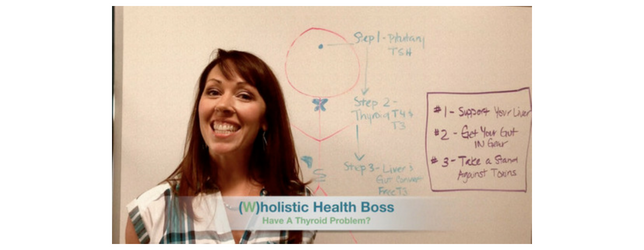
Are you struggling with feeling fat, sick and/or tired all the time?
Did you know these could be signature signs of an underlying thyroid problem?
It has been estimated that 12% of the U.S. population will develop a thyroid condition sometime during their lifetime.
And of those people, up to 60% don’t or won’t know they have a thyroid issue (usually because it’s been misdiagnosed).
And women are 5-8 times more likely to have a thyroid condition than men.
I know I’m part of the 12%. Could you be too?
If you struggle with high cholesterol, depression, weight gain, relentless fatigue, feeling unwell often or even constipation you just might have a thyroid problem.
If you don’t know, the thyroid is a hard working, butterfly shaped gland that sits right at the front of your throat. It produces a variety of thyroid hormones and is part of the endocrine system, which is a group glands that work together and produce hormones.
The thyroid is in charge of some really critical bodily functions such as:
- Appetite, absorption of nutrients and digestion of fats
- Heart rate, heartbeat strength and the intake of oxygen
- Blood flow and body temperature
- Cellular energy production
- Brain development and maturation
- Sexual function, sleep and thought patterns
So I’d say it’s pretty important to make sure your thyroid is up and running, and to be aware IF you might have, or be at risk for, a thyroid condition.
Symptoms of a thyroid condition can include:
- Constipation, bloating or weight gain or loss
- Depression, anxiety or mood swings in general
- Hair loss, facial hair growth, dry hair or skin
- Irregular periods, infertility, miscarriages, or low libido
- High cholesterol, heart racing or trouble breathing
- Cold hands or feet, or feeling cold when others aren’t
- Fatigue even after a full night’s sleep or brain fog
And those are just some of the most the common ones.
Because the thyroid oversees so many actions in the body and symptoms can be far removed from the root cause, the thyroid is often overlooked as a factor when your health heads south.
In this week’s video and blog I’ll help you get to know your thyroid a little better so you can get to the bottom of a potential thyroid problem or prevent one in the future.
The traditional approach to testing thyroid function usually involves a blood test to look at Thyroid Stimulating Hormone, also known as TSH, and if you’re lucky your doctor might also include a marker for thyroid hormone T4 or T3.
But unfortunately traditional testing typically falls short when evaluating thyroid health for a number of reasons.
Let’s take a look at how the thyroid works first to understand why a traditional thyroid test might not give you all the clues you need to know if you have a hidden thyroid problem …
Step 1 – The pituitary gland releases Thyroid Stimulating Hormone (TSH) to do exactly what it implies, to stimulate the thyroid to do its job, making TSH more of a direct marker for pituitary function and an indirect marker for thyroid function.
Step 2 – The thyroid gland produces an abundant amount of inactive T4 and a small amount of inactive T3 hormone known as “total” T4 and T3. These inactive versions actually can’t be used by the body, they have to be converted into active versions.
Step 3 – Various tissues of the body, primarily the gut and liver, convert Total T4 into “free” T4 and then into free T3, and Total T3 is also converted into free T3, making thyroid hormone available for use by the body. Some Total T3 is also converted into Reverse T3, a signaling hormone that stops the uptake of T3 into the cells when they’ve had enough.
Seems a little complex, right?
Do you see how a standalone TSH test, or even one that includes an additional thyroid hormone marker or two still leaves a lot to be wondered about in regards to how your thyroid might actually be performing when you consider all of the moving pieces?
To more accurately evaluate your thyroid health and function, you’ll want to ask your doctor or health practitioner (like me!) to run a full thyroid panel that includes at least:
- TSH
- Total AND Free T4
- Total AND Free T3
- Reverse T3
- Plus both thyroid antibody markers TPO and TG Ab
If you suspect you have a thyroid problem and can’t get your hands on a full thyroid panel, or if you just want to prevent a thyroid problem from developing, there are some proactive steps you can take to boost your thyroid health…
#1 – Support Your Liver
Believe it or not, but your liver plays a pretty big role in keeping your thyroid healthy. It’s where a good chunk of thyroid hormone is converted, plus it gets rid of excess estrogen and toxins which can trigger a thyroid problem. Eat liver supporting foods such as beets, dandelion greens, and grapefruits, and consider taking a good quality liver support supplement daily such as this one.
#2 – Get Your Gut In Gear
Your gut is where another big chunk of thyroid hormone is converted for use, and it’s where you absorb nutrients to produce thyroid and other hormones necessary to keep your body in balance. If your gut is a mess, your thyroid will be too. Pay attention to how foods make you feel and avoid the ones that upset your stomach or make you feel gassy and bloated – you can also do a food sensitivity test to specifically identify what foods might be wrecking your gut. Also aim to incorporate gut healing foods and substances such as bone broth, collagen peptides and a good quality probiotic.
#3 – Take A Stand Against Toxins
On average an adult uses 9 personal care products each day, with 126 unique chemical ingredients, most of which are known as endocrine disruptors meaning they directly and negatively affect thyroid function. And that’s doesn’t include toxins encountered in household cleaning products, bathing water or foods. Do your thyroid a favor and take a stand against toxins. Eat organic foods as much as possible, only drink and cook with filtered water, and shift to using non-toxic environmentally friendly cleaning and personal care products such as BeautyCounter.
If you’re proactive in these 3 areas you’re going to significantly lighten the load on your thyroid so it can return to balance or stay that way.
Taking action in these 3 areas helped me restore my thyroid function, too, so I could lose weight, get my energy back and start feeling like myself again, and I still practice them to keep it that way!
If you need help getting your hands on the right lab tests and resources to uncover a possible thyroid problem or restore its function, then schedule a complimentary Ideal Health & Weight Discovery Session with me today here!
It’s time to part ways…

After a year of holding on to my WP Thyroid medication, it’s time for us to part ways; it’s time to move on and I’m ready for the next chapter.
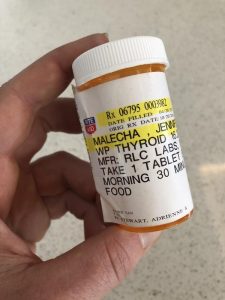
A little over a year ago, I received the news that I was officially in remission with Hashimoto’s (an autoimmune thyroid disorder) and I could quit my medication, just 7 months after receiving my diagnosis!
This was a HUGE milestone!
There is a misconception out there about medication, once prescribed you’ll always need it, but that’s not always the case. As my mentor, Reed Davis (the founder of Functional Diagnostic Nutrition) says, “the general principles of health will always outperform specific treatments.”
When I initially received my diagnosis back in October 2016, it felt as though the cards were stacked high against me for a quick recovery. Just months prior to my diagnosis I had discovered toxic mold in my home, which led to a hormonal imbalance in my body known as estrogen dominance.
Within weeks after receiving my diagnosis, a home mold test showed the extent and severity of the mold was much more than I had even anticipated.
To top it off, within the same week of finding mold in my office, my mom also passed away. My body was taking a beating from all of the physical and emotional stress, remission seemed far-fetched.
I had a collaborative conversation with my Naturopath and made a conscious decision to take thyroid medication to acutely support my body in its time of need. In addition, I committed to doing the work that need to be done to rebuild my health using diet, rest, exercise, stress reduction, toxin removal and supplementation so I could get off the medication as quickly as possible.
One year later I’m still in remission, medication free but still holding onto it.
I’ve been hanging onto my thyroid medication as back up, “just in case” I wake up one day not feeling like myself again. But the truth is I’ve been feeling like myself again for a while, despite not always being perfect in my food or lifestyle choices, because I’ve created the space for my body to heal AND because my body and I have a stronger relationship than ever before
Part of healing from any health condition is learning to trust your body again. Competitive athletes are great examples of this.
Competitive athletes may never get back in the game even after weeks of physical therapy and hours of field practice post injury, if they don’t get their mindset right and learn to trust their body again – learn to trust their leg, arm or whatever body part was injured to do its job and support their play.
If they’re always second guessing whether their body is going to work for them or not, their head will never be back in the game.
I’ve also been learning to trust my body again so I can play my best in the game of life.
Trusting that one bite, one drink, one intense workout or one late night won’t throw me into a thyroid talespin again. Trusting myself to make good decisions in any given moment that best support my health, and to not go back to the ways which burdened my body. Trusting that it’s possible to live life to the fullest while being the healthiest version of me.
In this week’s video and blog I share more about getting over my fear, giving up my thyroid medication crutch and this new chapter of my health journey.
Fear can be a limiting factor when it comes to your health.
Fear of not fitting in or being “that person” at dinner might hold you back from changing your diet or making food choices to support your health.
Fear of being judged as someone who doesn’t work hard enough or as a slacker might prevent you back from creating healthy boundaries around work and making yourself more of a priority.
Fear of being seen as weak if you go for a walk instead of run, or don’t lift heavy in the gym might encourage you to push your limits and stress your body more than you should.
Fear of not meeting a deadline, losing connection with your partner or being a party-pooper might keep you up late and rob your body of the critical sleep it needs to function properly.
Fear of a Hashimoto’s and mold illness relapse kept me hanging onto a thyroid medication I didn’t need, and questioning the safety of my home for way longer that I probably should have.
And not trusting that my body could remain healthy on its own fueled my fear.
To be quite honest, I felt limited- I held back from doing things that might have made me happy or given me joy because I was afraid of what might happen to my health if I did.
Getting past fear and trusting my body again gave me freedom.
This might come off as a little too “woo-woo” for some of you, or as if I’m some kind of spiritual gangster, but as a result of my own experience I do believe that part of healing the physical body involves healing the mind and believing.
Believing you can be healthy.
Trusting that your body has your back.
Having faith that what seems impossible, is possible.
Knowing your body wants to be in balance, and if you work together you can get there.
There’s two parts of the work I do with clients. One part science, with all the fancy functional lab tests along with a specific and strategic health re-building plan.
And one part mindset. Learning how to be different because part of who you are being is either helping or hindering your health.
Like I always say… “Healthy is a way of being, not doing.”
It’s not just about doing all the “healthy things” and going through the motions. Healthy is about learning to live differently to support your health.
If you change your diet but don’t change the relationship or how you perceive food, you’ll easily revert back to your old ways.
If you adopt a new exercise routine but hate it, you’ll soon find an excuse not to do it.
If being fat, sick and tired all the time is all you know, or all you’ve known for a long time, you may not know how to think or act differently.
I’ve been in your shoes, I’ve had the same struggles too. And I’ve put in the work to change it. This is how I know I’m ready to say goodbye to WP Thyroid. I can trust my body and know it can trust me too.
Getting rid of my thyroid medication is like kicking off the training wheels of a bike. I’m ready to ride on my own because I know if I hit a bump in the road I’ll regain my balance. If I fall off I can get back up. If I lose my way, I can find it again. And no matter what happens, if I trust my bike to get me somewhere, the places I can go are limitless.
I’m ready to just be healthy. Not with a side of Hashimoto’s, medication or mold illness. Just healthy and just me.
If you’re ready to just be healthy, even if you don’t know how to get there, then I’m ready to be your guide so you can actually fix what is wrong and get back to feeling like yourself again (or for the very first time!).
Let’s explore the possibilities, schedule a complimentary Ideal Health & Weight Discovery Session with me today here!
What weight loss is really about…

How many diets, exercise routines or cleanses have you tried in order to lose weight?
Over the years I’ve tried almost too many to count.
Back in the day as a personal trainer, I was constantly switching up my workout routine trying to chase down the weight loss results I wanted so I could have the confidence I was looking for.
I cut calories. I tried carb cycling. I tried eating every two hours.
I set lofty goals to train for fitness shows and marathons in pursuit of the perfect body.
But even with my best efforts, I could only lose a few pounds and the second I stopped, I would put them right back on.
Trying to lose and maintain weight loss was frustrating, to say the least.
And to make matters worse, I was exhausted all the time, I would crack under pressure or stress, sometimes anxiety would get the best of me and I just didn’t feel like myself.
Once I realized what weight loss was all about, not only was I able to manage my weight better but I also had little to no anxiety, and got my energy and my old self back.
You have to get healthy to lose weight, not lose weight to get healthy.
Sometimes we have to let go of what we think we know in order to open the door for change. When the typical approach of diet and exercise just aren’t working anymore (or maybe they never did), then you have to dig deeper in order feel great in your own skin again.
When I dug deeper, I found a gold mine of reasons why I struggled so much with weight, energy, stress and ultimately confidence.
It wasn’t for a lack of effort. I had underlying health issues that were preventing my body from being in balance.
I unknowingly suffered for who knows how long from adrenal dysfunction, a sluggish liver, high levels of cellular damage and a variety of intestinal parasites, bacteria and yeast.
As soon as I resolved those underlying issues, my weight dropped, my energy went up and I felt like I could conquer the world!
In this week’s video and blog I share with you what weight loss is really about, how to find what’s getting in your way and how to go about losing weight.
I’ve struggled with weight more than once in my life.
Shortly after achieving my perfect body, regaining my confidence and resolving my adrenal, liver, cell and gut dysfunction, I slowly started packing on the pounds again. A total of 15 over two years.
The story was the same. I was doing everything right when it came to diet and exercise, in addition to supporting my body better than ever before with sleep, supplements and daily stress reducing activities.
Yet the weight kept coming, meaning this time I had to dig even deeper than before.
My investigation revealed elevated levels of estrogen and Hashimoto’s, an autoimmune thyroid disorder.
With these insights, I quickly took action to lower my estrogen and support my thyroid. The weight loss was slow but steady, and I’m happy to report I feel comfortable in my skin once again.
As we get older, it can get harder to lose weight, but it’s not impossible. You’re not destined to be overweight. It just might take a little bit longer to untangle unidentified dysfunction that’s been taking place for years in your body in order for you to get healthy and support your body in losing weight.
I’ve worked with many clients well over the age of 40 who have lost over 40 pounds without having a workout routine in place or counting a single calorie. We simply focused on uncovering hidden healing opportunities using functional lab testing and used this information to create a personalized health re-building plan that led to weight loss.
Losing weight is really about identifying “hidden healing opportunities.”
Hidden healing opportunities could be any kind of underlying dysfunction in the hormone, immune, digestion, detoxification, energy or nervous system.
Typical blood tests from your doctor won’t usually pick up on this kind of stuff, because it’s happening at a functional level. You may already suspect this if you’ve been suffering from other unresolved health issues (aside from weight) such as:
- Anxiety, depression or inability to handle stress
- IBS, gas, bloating or digestive upset
- Thyroid issues that aren’t getting better
- Low/high testosterone, estrogen or progesterone
- Infertility, painful or irregular periods
And the list could go on.
Weight is really a meter for how well all of the systems of the body are OR are not working together.
For example, as I discussed in last week’s blog, inflammation, toxins and insulin levels play a huge role in the accumulation of belly fat. It’s not just about diet and exercise.
Weight loss woes are symptom of something else, especially when diet and exercise aren’t doing the trick.
Before you go spending money on lab testing to uncover your hidden healing opportunities to promote weight loss, try this…
- Cut out the top inflammatory foods: gluten, dairy, sugar, soy and alcohol
- Be asleep by 10pm at least 5 nights per week
- Move your body daily for 20 minutes or more in a way that feels good to you
- Create a daily deep breathing or meditation routine
- Support bodily functions with a high-quality probiotic and multivitamin formula that includes antioxidants and liver support
If you practice these 5 things for 30 days and the weight still won’t budge, that means your weight meter is telling you to dig deeper.
I support busy, health-mind professionals just like you, in taking back control of your health by giving you access to the right lab tests and resources to find the missing pieces of your health puzzle so you can actually fix what is wrong and get back to feeling like yourself again.
Using over a decade of personal training experience, training in Functional Diagnostic Nutrition and Transformational Coaching, I create personalized health-rebuilding programs for clients that are realistic and sustainable for long-lasting results, and that empower them to be the boss of their own health.
If you’re ready to look at the “big picture” of your health (not just one disconnected piece at a time), to embrace healthy as a way of being, and to stop settling for anything less than you deserve when it comes to your health and happiness then, schedule a complimentary Ideal Health & Weight Discovery Session with me here today!
Belly Fat Facts

I would say that 90% of the people I talk to would love to lose weight around their midsection. Most of them are seeking that ever so elusive flat stomach.
Are you one of those people?
If you are, I have good news for you…
There’s still time to flatten your stomach for summer!
And it doesn’t require counting calories, crash dieting or spending hours at the gym.
Because the fact of the matter is, belly fat is NOT always a result of eating too much and exercising too little. In fact, calories in versus calories out is a dying school of thought.
There is a plethora of research these days showing just how broken the calorie counting and crash dieting approach is. In fact, cutting calories and crash dieting can actually cause weight gain long-term.
Everywhere you turn you’ll see all kinds of marketing, promotional products and advertising geared towards the calories in versus calories out method for weight loss and finding that flat stomach.
And yet, people still struggle to lose or maintain weight loss, even when they’ve tried almost every diet and exercise routine out there.
And what about the people who have stick skinny arms and legs but are round in the middle – what’s their story?
What’s up with that belly fat that just won’t budge?!
The accumulation of fat in our bodies, and particularly around our midsection, is way more complex than what is portrayed in mainstream health.
Diet and exercise actually play a small role in the reason for fat around your midsection. In some cases, eating “healthy” and exercising can even contribute to fat accumulation.
Here are some facts about belly fat that I bet you didn’t know…
Excessive inflammation increases your storage capacity for fat cells, particularly white fat cells which are directly related to your “spare tire.”
White fat cells that accumulate around your midsection also serve as a protective mechanism to store the toxins you’re exposed to in order to prevent them from affecting your brain. So the more toxins you’re exposed to, the more white fat cells you make and the bigger the spare tire gets.
Constipation and poor liver detoxification can lead to a build up of toxins in the body which creates even more white fat cells around your midsection.
Excessive amounts of white fat cells trigger even more inflammation which can result in fluid retention (edema), resulting in even more white fat cells! And a toxic body will intentionally hold onto fat to hide toxins in order to protect you and your brain from the re-circulation of toxins if they are not eliminated.
Low glutathione levels reduces mitochondrial function which leads to weight gain or loss resistance. Glutathione is the body’s most powerful antioxidant and mitochondria are the organelles within our cells generate energy from the food we are eating.
Insulin resistance or carbohydrate intolerance contributes to a fatty liver. All of which contribute to inflammation overload and poor toxin detoxification.
Do you see now why diet and exercise aren’t enough to get rid of belly fat?
In this week’s video and blog I straighten out the facts about belly fat and give you tips so you can get that flat stomach for summer.
Now, that you know the facts about belly fat, it might seem like getting rid of is much more complex that you originally thought.
In some sense this is true. Diet and exercise are a part of it, but alone won’t get rid of it.
Don’t lose hope, though.
There are four simple steps you can take to reduce your inflammation and toxic load while boosting your liver function and glutathione levels to help you get that flat stomach for summer.
Step 1: Boost Glutathione & Liver Function
Your body needs cysteine (a sulfur-rich amino acid), B2 and selenium to make glutathione and for your liver to function optimally. Eat foods rich in these nutrients such as: organic grass fed red meat, wild salmon, eggs, chicken, lamb, almonds, brazil nuts, tuna, halibut, broccoli, cabbage, cauliflower, asparagus, onions, mushrooms, and spinach.
Step 2: Cut Down Carbs (especially processed ones)
This one should be easy if you focus on replacing carbs, especially processed ones, with some of the nutrient rich foods mentioned above. Eating too many carbs in one sitting, or multiple times a day can oversaturate your cells with glucose causing insulin resistance, even in the “healthiest” people. Focus replacing your carb intake by bumping up your healthy fats with avocados, fattier cuts of organic meat and poultry, and oils such as olive, coconut and avocado oil. This will cut your carb cravings, leave you feeling fuller longer and less bloated.
Step 3: Minimize Toxic Exposures
We can’t always control what toxins we are exposed to because we can’t always see, hear, smell or feel them BUT taking action to control the ones you are aware of can drastically reduce the toxic load on your body. Some swift and strategic toxin reducing actions you can take include: using non-toxic home cleaning and personal care products, drinking and cooking with filtered water only, getting a HEPA air filter for your bedroom and office, and getting outside for fresh air multiple times a day.
Step 4: Reduce Inflammation
By minimizing your toxic exposures, cutting down on carbs, and boosting your liver and glutathione levels you’ll already be on your way to reducing inflammation. There are a LOT of other unforeseen things that can cause inflammation such as food sensitivities, parasites, bacteria and yeast overgrowth in the gut. To sort out these other inflammatory agents you’ll need to do some testing. But you can also take reducing inflammation to the next level by getting to bed by 10pm and avoiding the top most toxic and inflammatory foods such as gluten, dairy, sugar, soy and alcohol.
I can almost guarantee, if you practice these simple steps every day, your belly fat will start going away in 30 days (or less!).
And if you still feel stuck with belly fat that just won’t budge, let’s test so you don’t have to guess about it anymore!
To get your hands on the right lab tests and resources so you can find the missing pieces to your health puzzle and start feeling like yourself again (or for the first time!), schedule a complimentary Ideal Health & Weight Discovery Session with me here today!
#TBT Why Blood Tests Don’t Tell You Squat

It’s time for another Throwback Thursday blog!
This one comes to you in honor of World Thyroid Day, which just took place on May 25th, AND because this topic has been coming up time and time again in conversations I’ve been having with people.
I can’t tell you how many times someone has told me…
My blood work came back normal, but I still _________
feel exhausted
can’t lose weight
can’t get pregnant
get bloated and have stomach pain
can’t stop losing hair
feel anxious or depressed
(fill in the blank with your symptom)
There is no such thing as a perfect test, and blood tests certainly don’t provide the full picture of what’s going on with your health.
So I’m bringing this blog back to help you find the right tests and resources you need to find the missing pieces to your health puzzle so you can get back to feeling like yourself again!
***
I received one of the most disturbing messages from a client less than 48 hours before I went live with my webinar Why Typical Blood Tests Don’t Tell You Squat (and what tests to run instead).
This client, we’ll call her Sarah to conceal her identity, started working with me in December of 2015 after participating in one of my Seasonal Cleanse challenges. She was attracted to the Cleanse Challenge for its promise to boost energy, get rid of belly bloat, gain a flat stomach and an overall improvement in health.
Sarah enjoyed the cleanse challenge and saw some results, but it was obvious she needed more help, which is how we came to work together.
We ran some tests, identified some healing opportunities within her hormones and digestive system, got her started on the right diet for her body and some supplements to support the body’s healing process. Within a matter of weeks, she was feeling great!
For months after starting our work together Sarah saw significant improvements in how she felt and looked. Her anxiety dwindled down to almost nothing, her energy was up, she felt better in her body and her digestion was on point.
After about a year of being on her health re-building program, she hit a wall with her results and almost started going backwards.
I encouraged her to run a full thyroid panel for clues and that’s when she was diagnosed with Hashimoto’s.
Since then, Sarah and I have continued our work together to help her manage her Hashimoto’s with a holistic lifestyle approach, which included redefining her diet to support the healing process, changing up her supplements, taking more time for herself and working to eliminate toxins that disrupt thyroid function.
Part of Sarah’s health re-building plan also included following her dreams to leave New York City for the West coast or some area that better supports her health.
As she was getting ready for her upcoming move to the west coast in February and going through old paperwork, she came across this doctor’s report from 2009…
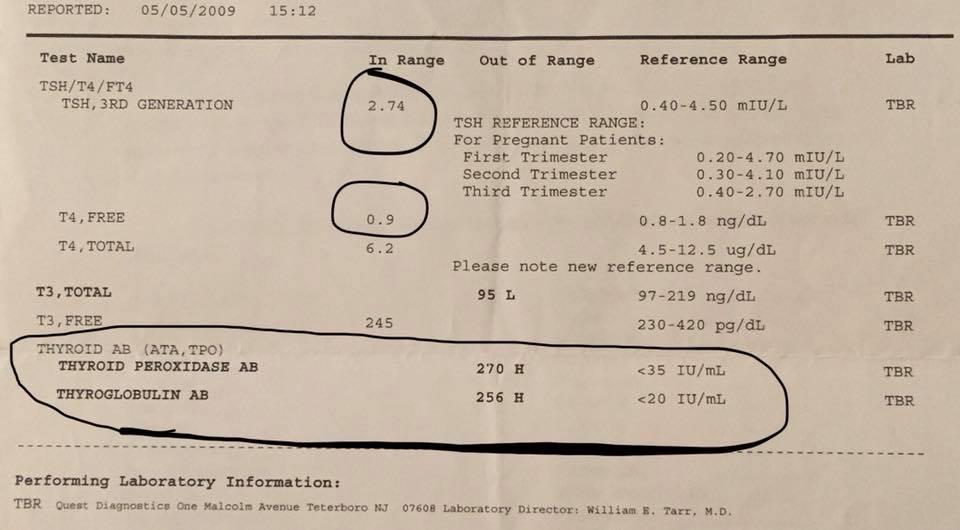
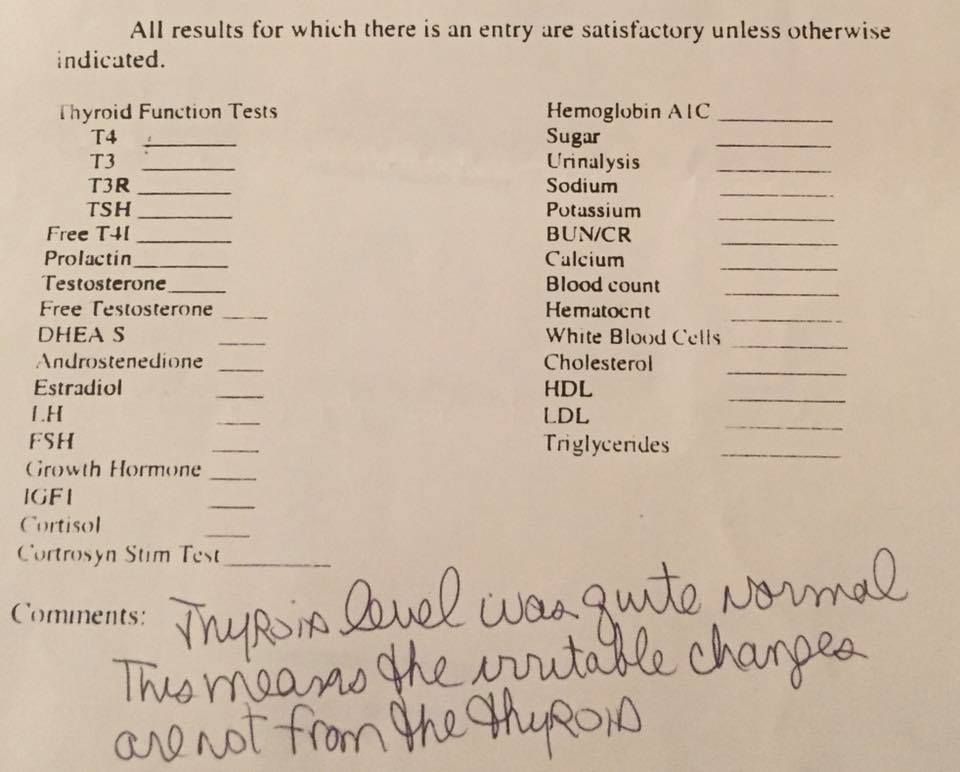
Back in 2009, Sarah clearly had Hashimoto’s that was overlooked. Her thyroid antibodies were well over 200 and even marked as “high” according to the traditional conventional lab references ranges.
Her TSH was high when compared to the optimal/functional range of 05.-2.0 and her Free T4 was on the lower side of the conventional range and the optimal/functional range.
Her health practitioner completely dismissed her thyroid results, even though Sarah was symptomatic, and even noted “Thyroid level was quite normal. This means the irritable changes are not from the thyroid.”
Had Sarah received a proper interpretation of her test results, or been more well informed to advocate for herself, she quite possibly could have reversed her Hashimoto’s 8 years ago. I can’t even begin to image how much different her life would be today. She could have been living a high energy, flat stomach and symptom-free life for the past 8 years had she known better.
This is the perfect example of why I just hosted the webinar Why Typical Blood Tests Don’t Tell You Squat (and what tests to run instead), and why I’m sharing the recording with you.
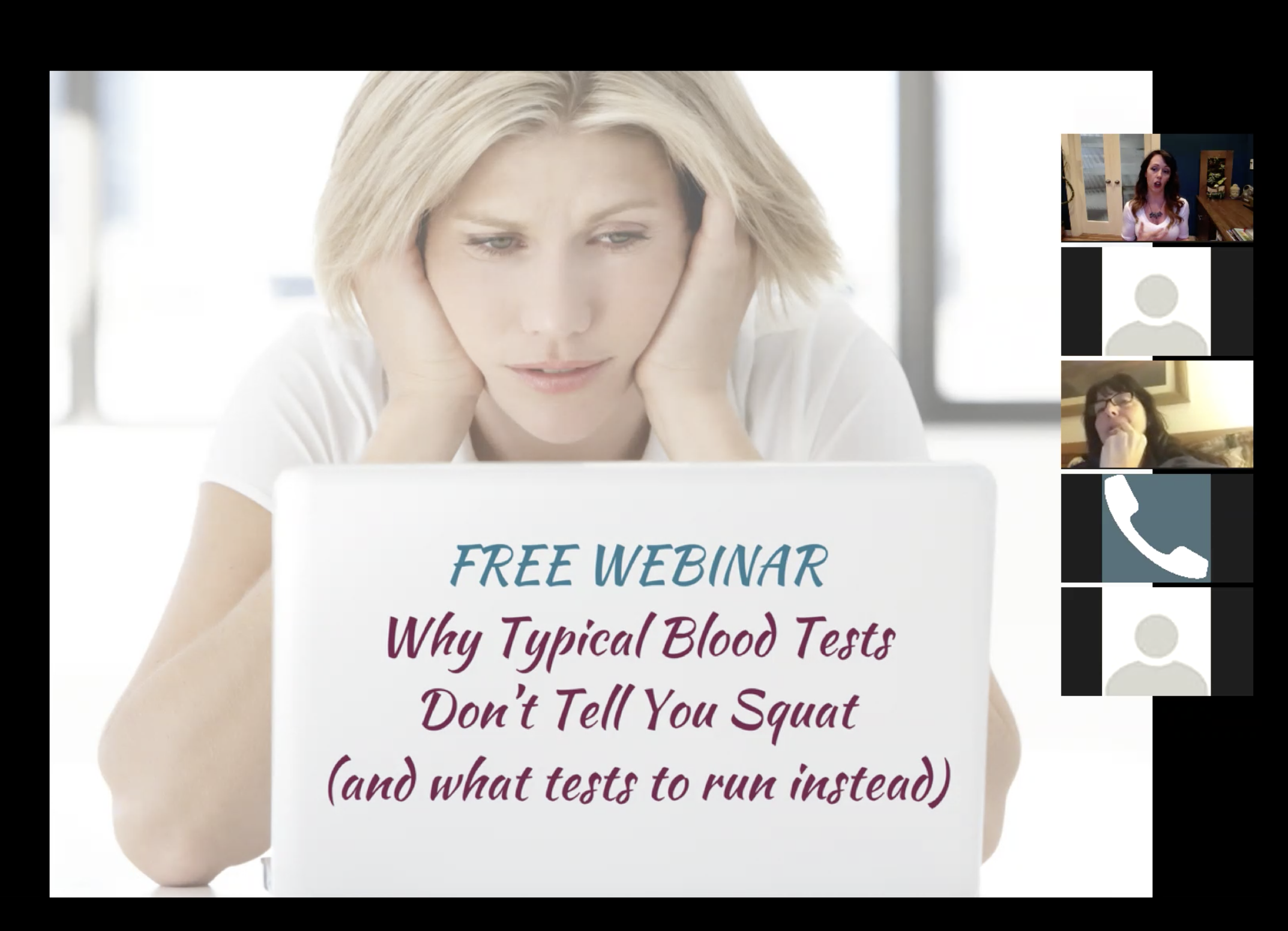
It’s time to put a stop to this confusion and to become educated about what your lab tests are really saying, or to figure out the right labs to run so you can become your own advocate and take back control of your health.
Access the webinar replay here!
In this webinar, I uncovered these truths about lab tests as it relates to your health:
- How blood and saliva tests don’t tell the full story about your hormones and what health secrets are hiding in your urine
- What’s wrong with lab reference ranges, how they could be lying about your health and what optimal ranges look like
- How markers on a comprehensive blood panel all give you clues about your gut health
- Why you should be running functional (not conventional) lab tests to find the missing pieces to your health puzzle
It is possible for you to have better energy, mental clarity, clear skin, a flat stomach and/or to feel good in your body again. You just need the right lab tests and resources to give you the right clues so you can find the missing pieces to your health puzzle and get back to feeling like yourself again (or for the first time!).
Access the webinar replay here!
***
I hope you find this week’s blog and webinar replay insightful, and empowering.
I like to say that I’m in the business of making the impossible, possible.
So if you find yourself feeling stuck, being told that “everything looks normal” by other health professionals, yet you know something just doesn’t feel right in your body, then schedule a complimentary Ideal Health & Weight Discovery Session with me here today!
What foods are right for you?

Did you know there is a difference between eating healthy and eating right for your body?
Eating right for your body will include healthy foods, but not all healthy foods are right for your body.
What makes a food “healthy” anyways?
According to the dictionary, the word “healthy” means…
“in good health.: “I feel fit and healthy” “the family is the basis of any healthy society”.
So how does that apply to food then?
We tend to lump a bunch of foods under the definition of healthy – ones that we’ve been told are healthy because of certain nutritional values they hold. “Healthy” foods tend to be: high in vitamins and minerals, low in calories and sugar, and great sources of fiber and healthy fats according to who ever makes up these standards around healthy foods.
I think most of us would agree that these foods would fall under the definition of healthy because of their nutritional value…
- Organic vegetables
- Organic fruits
- Organic meats, poultry and fish
- Organic nuts, seeds, beans and legumes
Yet, not all of the foods in these categories are right for my body and they may not be right for yours either.
Last week I was reminded of this lesson when I ate something that appeared to be healthy on the outside but wasn’t quite right for my body on the inside.
Check out the Facebook Live Video where I share my experience, the friendly reminders my body gave me and how to know what healthy foods may not be right for you…
From the outside the food that I ate last week looked super healthy. It had clean ingredients, it was certified gluten free, Paleo, vegan, Whole30 approved and all that jazz.
Initially after eating this apparently healthy food for dinner, I felt fine. But the next morning was a different story. My body gave me all kinds of signs that this apparently healthy food, or combination of ingredients was not working for me.
After being diagnosed with Hashimoto’s in 2016 I started eating a modified Autoimmune Paleo (AIP) diet to reduce inflammation, lower my thyroid antibodies and to allow my body to heal. After about 3 months my antibodies were down, I had lost some weight, I was feeling great and I was able to reintroduce some foods I had been avoiding.
Upon reintroducing foods, I quickly realized that some of the healthy foods I used to eat, such as bell peppers, chia seeds and walnuts, didn’t agree with me although they are “healthy”. Over time, as my gut has healed more, I’ve been able to add certain foods back in small amounts while still feeling great BUT red bell peppers and chia seeds still aren’t my friends.
I was able to figure this out by simply paying attention to how my body responded to certain foods and by using functional lab testing to identify what foods my body needs to function at its potential.
If you feel as though you “eat healthy” but aren’t getting the results you want, have tried every diet and they don’t work, or just plain stuck when it comes to losing weight or improving your health, then it’s likely because there is a difference between eating healthy and eating right for your body.
You could be eating the healthiest foods in the world BUT if they aren’t right for you, you won’t get the results you are looking for.
To figure out what foods are right for you…
1 – Tune Into Your Body
Often we are eating on autopilot and not recognizing or connecting with how foods make us feel. Reactions to foods can happen immediately or be delayed for as long as 72 hours. Reactions to foods can show up in various ways – not just as digestive upset. Check in with yourself 30 minutes to 2 hours after eating a meal to assess your mood, energy and how your physical body feels. If you feel anxious, tired, bloated, gassy or just “off”, this could be a result of something you ate.
These same symptoms can also show up over the course of 3 days after eating something that doesn’t agree with you. If I get “glutened” (secretly slipped some wheat) then I’m guaranteed to have anxiety for the next day or two.
Other signs of food reactions can also include: acne, eczema, psoriasis, irregular menstrual cycles, joint aches and pains, issues sleeping and more! If your symptoms come and go, start tracking them along with what you ate and see what you can correlate!
2 – Test Don’t Guess
Tuning into your body to find out what foods serve you best is the key, but sometimes the signs may not be super clear. Food sensitivity testing can pinpoint exactly what foods your body is reacting to so you can take empowered action to support your body with the foods you need.
Generally, food sensitivities are a result of having a leaky gut and they only need to be avoided for a period of time to help the gut heal. Once your gut is in a better place, you can retest your food sensitivities to see which ones have improved for those that can be added back in, and which ones still might not be right for your body.
Don’t be fooled by “eating healthy.”
Simply eat right for your body, and take the time to understand what healthy means for you.
If you want to figure out what foods ARE right for your body, OR how to heal your gut so you can enjoy some of your favorite foods again, then schedule a complimentary Ideal Health & Weight Discovery Session with me here today!
Let’s K.I.S.S.

I’m just getting back into the groove of things after attending the Paleo F(x) and National Association for Nutrition Professionals conferences where I was surrounded by some of the biggest, brightest minds in the functional and holistic health world.
I’m beyond excited about the plethora of new research and information coming out at light speed in regards to health and wellbeing.
It’s absolutely fascinating, but I can’t help think that we are overcomplicating things.
There was a ton of talk at the conferences around new health monitoring gadgets and lab testing, which is all great, but you could spend thousands of dollars and hours chasing results trying to find an answer that may already be within you.
Chasing so-called standards of health, diets and exercise is not the answer.
Don’t get me wrong, I’m a big fan of using functional lab testing and different health monitoring tools to find clues and healing opportunities, but the most intelligent and powerful tool you have is your body.
Your body holds all of the answers. Lab testing and health monitoring tools simply provide clues that can correlate with your symptoms and help point you in the right direction.
The pursuit for better health is like a scavenger hunt. You don’t know exactly what you’re looking for, but can use lab tests and health gadgets to collect clues along the way to eventually find the treasure.
Going on a health scavenger hunt can feel overwhelming and complicated.
Sometimes we have to throw what even the experts are saying out the window and just tune into our own body.
For lack of better words, sometime we need to K.I.S.S. – keep it simple, stupid (KISS).
This is a phrase I picked up in my previous days of project management in the corporate wellness world when projects started to get out of control.
Regardless of the situation, the basic and general principles of health will almost always outperform specific treatments anyways.
At any point in time you can tune into your body and recognize if your current strategy around diet and lifestyle is working for you or not. You don’t need a test or gadget to tell you that.
This innate ability to know what your body needs, without the use of lab testing or health monitoring tools is something that has been passed down for generations, yet connecting with our body has almost been lost in our material world.
In this week’s video and blog I talk more about tuning into your body, tuning out what the experts are saying and what we can learn from our elders to create better health.
Some of the most common questions I get asked by people who are seeking better health are related to diet and exercise.
Diet and exercise are topics we have certainly made overly sophisticated and complicated.
I see so many people get lost, frustrated and eventually giving up on their health because they’ve been chasing down a diet or exercise routine that works for other people but may not be right for them.
When my friend Jason Prall traveled the world studying the healthiest populations, the first question he got from people back in the US was: “how did they eat?”
It’s no doubt that when people think about health and longevity, diet and exercise are the top two subjects on most people’s minds.
Jason didn’t find the healthiest and longest living people on the planet eating one particular type of diet or doing one kind of exercise.
What he did find was that without any lab tests or health monitoring tools, the healthiest, oldest people on the planet are healthy because they keep it simple.
They simply get up when the sun rises in the morning.
They simply eat what is local and seasonally available.
They simply move their body every day by walking or working.
They simply spend quality time with family and friends.
And they simply go to bed at a reasonable hour after the sun sets.
Why do we try to make the pursuit of health and longevity so complicated?
This is exactly why Episode 3 of The Human Longevity Project resonated with me.
It cuts through the noise and dispels many the myths surrounding these sometimes polarizing topics of diet and exercise that we make so complex, and it focuses on the simple facts that truly promote health.
Episode 3 investigates the diet, eating habits, and how the healthiest populations view movement and exercise. You might find it fascinating that there isn’t a single “diet” that is uniform across all of these cultures.
Yet some recurring and simple themes among them all included: meals consumed in a communal setting with friends, family, and neighbors, and eating traditionally-prepared, locally raised & produced, seasonal, and non-processed foods as a significant majority of their diet.
The episode also shows how overly restrictive diets (common now in western world) are detrimental, over time, to the health and diversity of our microbiome – which requires a wide variety of plant foods to thrive.
The healthiest and oldest people across the world have lived a life full of health because they keep it simple in so many ways.
Episode 3 of The Human Longevity Project is sure to be one of the most talked about episodes in this one of a kind documentary and I don’t want you to miss it.
Tune in at 5:00 Eastern Time Here To Watch It! – and learn how you can keep it simple too.
P.S. In case you missed any of the previous episodes or want to watch them again, there’s an encore weekend happening May 19th so still sign up to get episode 3 here and you’ll get notified when it is released again!
Why these people don’t get “common” diseases

An estimated 50 million people, in the US alone, are struggling with autoimmune disease. Some know it and others don’t.
Some don’t figure it out until they are older or it’s too late to reverse the destruction.
That number gets exponentially higher when you add in the laundry list of other chronic diseases such as:
- ALS (Lou Gehrig’s Disease)
- Alzheimer’s Disease and other Dementias
- Arthritis
- Asthma
- Cancer
- Chronic Obstructive Pulmonary Disease (COPD)
- Cystic Fibrosis
- Diabetes
What’s the point of living longer if your years are filled with illness, disease, pain, or things like dementia?
Sadly, this is the reality for people in their later years when they are supposed to be in the prime of their lives after kids have left the nest and retirement is reached, and it’s becoming all too much a reality for people even earlier in life.
These chronic diseases can be downright devastating to deal and so life-limiting in a number of ways when you’re having to deal with daily symptoms which might include:
- Fatigue
- Depression
- Pain
- Inflammation
- Skin issues
- Weight gain/loss
- Hair loss
- Dizziness
- Memory loss
In the midst of my own autoimmune crisis all I wanted was freedom from the burden of disease and, thankfully, I eventually found it.
If you or a loved one has been dealing with a chronic disease of some sort then I have something exciting to tell you about.
If you haven’t seen this, my good friend Jason Prall has produced one of the most anticipated documentary film series ever in the area of health.
It’s called The Human Longevity Project.
Jason and his film crew traveled the world to discover the secrets of longevity.
Here’s the good news….
There are populations today that are virtually free from the diseases that plague our world, proving it is possible for you or your loved ones too!
Here’s the best news…
Because you’re a part of my inner circle, Jason has personally asked me to invite you along for the journey so you can learn the secrets to living a long, happy and healthy life – for free!
In this stunningly beautiful series you will learn:
- Why people in certain areas around the world live longer, happier and healthier lives
- The underlying functions which allow them to be free of common diseases
- How to implement strategies into your own life to improve your bodily functions
- How to to get rid of debilitating symptoms
- So much more!
=> Go here to save your seat for this one-of-a-kind online event <=
This series has the power to change millions of lives for the better. Jason and I plan on doing just that by sharing this incredible information with as many people as possible.
Be sure to share this event with the people you care about. You don’t want them to miss out on this critical information so they can live their longest, happiest life too.
P.S. Don’t miss Episode 1 (starting soon): The Truth About Aging: Can It Be Slowed or Even Reversed?

